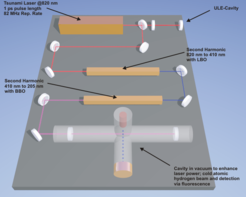1S-3S direct frequency comb spectroscopy
The measurement of a single transition gives only a limited information about the investigated system even if this transition is measured with an arbitrary good accuracy. By combing several measurements of different transitions a deeper insight is possible. In atomic hydrogen the interesting candidates are the Rydberg constant, Lamb shifts and the proton charge radius, that could deduced or verified by the different measurements. Thus the transition 1S-3S is interesting, because it use the same ground state as the 1S-2S experiment. For example, due to the n3 scaling of some QED effects, the Lamb shifts can be better investigated by the comparison of both experiments.
Beyond this basic consideration the setup of the 1S-3S spectrometer also uses a different approach compared to the 1S-2S spectrometer. Instead of using cw lasers with a narrow laser line-width the 1S-3S spectrometer based on mode locked titanium sapphire laser@820 nm with 1 ps pulse length and a repetition rate of 82 MHz. This laser produces a frequency comb which is the direct source of the light used for the spectroscopy as explained in the next section. The combination of a two photon spectroscopy with a mode locked laser gives on the one side the possibility of a high resolution spectroscopy down to the natural line width of the observed transition and on the other side also the access to high peak intensities of the laser pulses to drive nonlinear processes with high efficiency as second harmonic generation.
Experimental setup
A short description of the setup starts with a ps mode locked titanium sapphire laser at 820 nm with a repetition rate of 82 MHz, that is locked to a ultra low expansion cavity (ULE-Cavity). The free spectral range of the ULE cavity is ten times larger than the repetition rate of the laser so only every tenth mode of the laser is used for the stabilization. Using a cavity enhanced second harmonic generation the 820 nm is converted to 410 nm and this further converted to 205 nm also by a cavity enhanced second harmonic process. With the 205 nm a two photon excitation of the 1S-3S and also 1S-3D transition in hydrogen is possible.

The 1S-3S spectrometer is located inside a vacuum chamber, because a cold atomic hydrogen beam (T=6-8 K) is used. The atoms crosses the 205 nm beams, that is enhanced by a cavity in the vacuum. The excited atoms decay via the 3S-2P and 2P-1S transitions to the ground state and the emitted fluorescence is detected by a photomultiplier, which is also located inside the vacuum chamber.
Outlook
Using frequency combs the generation of deep UV light could be more efficient compared to cw lasers. Thus it would be interesting not only to measure the 1S-3S but the whole ladder 1S-XS with X=2,3,4,... . For this light down to 182 nm is needed. The methods to produce this light were already shown in other experiments.
